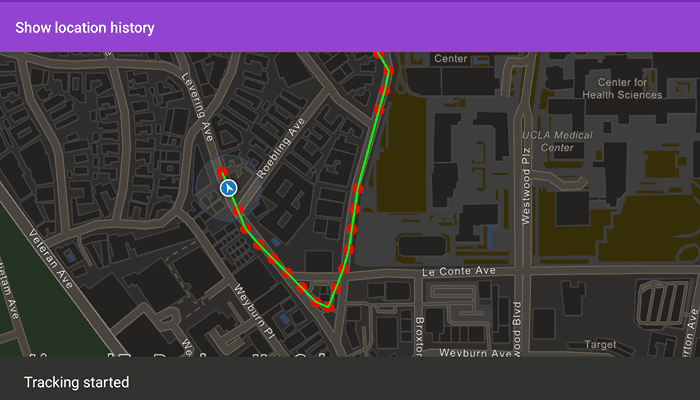Display your location history on the map.

Use case
You can track device location history and display it as lines and points on the map. The history can be used to visualize how the user moved through the world, to retrace their steps, or to create new feature geometry. An unmapped trail, for example, could be added to the map using this technique.
How to use the sample
Tap anywhere on the screen to start tracking your location, which will appear as points on the map. A line will connect the points for easier visualization. Tap the screen again to stop updating the location history. This sample uses a simulated data source. To track a user's real position, use the SystemLocationDataSource instead.
How it works
- Create a graphics overlay to show each point and another graphics overlay to display the route polyline.
- Create a
SimulatedLocationDataSourceand initialize it with a polyline. Start theSimulatedLocationDataSourceto begin receiving location updates. - Use
LocationChangedon thesimulatedLocationDataSourceto get location updates. - On location updates, store that location, display the location as a point on the map, and recreate the route polyline.
Relevant API
- LocationDataSource
- LocationDisplay
- LocationDisplayAutoPanMode
- PolylineBuilder
- SimpleLineSymbol
- SimpleMarkerSymbol
- SimpleRenderer
- SimulatedLocationDataSource
About the data
A custom set of points is used to create a Polyline and initialize a SimulatedLocationDataSource. This simulated location data source enables easier testing and allows the sample to be used on devices without an actively updating GPS signal. You should use SimulationParameters to ensure that the data source moves at a constant velocity over the polyline.
Tags
bread crumb, breadcrumb, GPS, history, movement, navigation, real-time, trace, track, trail
Sample Code
/* Copyright 2022 Esri
*
* Licensed under the Apache License, Version 2.0 (the "License");
* you may not use this file except in compliance with the License.
* You may obtain a copy of the License at
*
* http://www.apache.org/licenses/LICENSE-2.0
*
* Unless required by applicable law or agreed to in writing, software
* distributed under the License is distributed on an "AS IS" BASIS,
* WITHOUT WARRANTIES OR CONDITIONS OF ANY KIND, either express or implied.
* See the License for the specific language governing permissions and
* limitations under the License.
*
*/
package com.esri.arcgismaps.sample.showlocationhistory
import android.os.Bundle
import androidx.appcompat.app.AppCompatActivity
import androidx.databinding.DataBindingUtil
import androidx.lifecycle.lifecycleScope
import com.arcgismaps.ApiKey
import com.arcgismaps.ArcGISEnvironment
import com.arcgismaps.Color
import com.arcgismaps.geometry.Geometry
import com.arcgismaps.geometry.Point
import com.arcgismaps.geometry.Polyline
import com.arcgismaps.geometry.PolylineBuilder
import com.arcgismaps.geometry.SpatialReference
import com.arcgismaps.location.LocationDisplayAutoPanMode
import com.arcgismaps.location.SimulatedLocationDataSource
import com.arcgismaps.location.SimulationParameters
import com.arcgismaps.mapping.ArcGISMap
import com.arcgismaps.mapping.BasemapStyle
import com.arcgismaps.mapping.Viewpoint
import com.arcgismaps.mapping.symbology.SimpleLineSymbol
import com.arcgismaps.mapping.symbology.SimpleLineSymbolStyle
import com.arcgismaps.mapping.symbology.SimpleMarkerSymbol
import com.arcgismaps.mapping.symbology.SimpleMarkerSymbolStyle
import com.arcgismaps.mapping.symbology.SimpleRenderer
import com.arcgismaps.mapping.view.Graphic
import com.arcgismaps.mapping.view.GraphicsOverlay
import com.esri.arcgismaps.sample.showlocationhistory.databinding.ShowLocationHistoryActivityMainBinding
import com.google.android.material.snackbar.Snackbar
import kotlinx.coroutines.launch
import java.time.Instant
class MainActivity : AppCompatActivity() {
private var isTrackLocation: Boolean = false
// set up data binding for the activity
private val activityMainBinding: ShowLocationHistoryActivityMainBinding by lazy {
DataBindingUtil.setContentView(this, R.layout.show_location_history_activity_main)
}
private val mapView by lazy {
activityMainBinding.mapView
}
override fun onCreate(savedInstanceState: Bundle?) {
super.onCreate(savedInstanceState)
// authentication with an API key or named user is
// required to access basemaps and other location services
ArcGISEnvironment.apiKey = ApiKey.create(BuildConfig.ACCESS_TOKEN)
lifecycle.addObserver(mapView)
// create a center point for the data in West Los Angeles, California
val center = Point(-13185535.98, 4037766.28, SpatialReference(102100))
// create a graphics overlay for the points and use a red circle for the symbols
val locationHistoryOverlay = GraphicsOverlay()
val locationSymbol = SimpleMarkerSymbol(SimpleMarkerSymbolStyle.Circle, Color.red, 10f)
locationHistoryOverlay.renderer = SimpleRenderer(locationSymbol)
// create a graphics overlay for the lines connecting the points and use a blue line for the symbol
val locationHistoryLineOverlay = GraphicsOverlay()
val locationLineSymbol = SimpleLineSymbol(SimpleLineSymbolStyle.Solid, Color.green, 2.0f)
locationHistoryLineOverlay.renderer = SimpleRenderer(locationLineSymbol)
mapView.apply {
// create and add a map with a navigation night basemap style
map = ArcGISMap(BasemapStyle.ArcGISNavigationNight)
setViewpoint(Viewpoint(center, 7000.0))
graphicsOverlays.addAll(listOf(locationHistoryOverlay, locationHistoryLineOverlay))
}
// create a polyline builder to connect the location points
val polylineBuilder = PolylineBuilder(SpatialReference(102100))
// create a simulated location data source from json data with simulation parameters to set a consistent velocity
val simulatedLocationDataSource = SimulatedLocationDataSource(
Geometry.fromJsonOrNull(getString(R.string.polyline_data)) as Polyline,
SimulationParameters(Instant.now(), 30.0, 0.0, 0.0)
)
// coroutine scope to collect data source location changes
lifecycleScope.launch {
simulatedLocationDataSource.locationChanged.collect { location ->
// if location tracking is turned off, do not add to the polyline
if (!isTrackLocation) {
return@collect
}
// get the point from the location
val nextPoint = location.position
// add the new point to the polyline builder
polylineBuilder.addPoint(nextPoint)
// add the new point to the two graphics overlays and reset the line connecting the points
locationHistoryOverlay.graphics.add(Graphic(nextPoint))
locationHistoryLineOverlay.graphics.apply {
clear()
add((Graphic(polylineBuilder.toGeometry())))
}
}
}
// configure the map view's location display to follow the simulated location data source
mapView.locationDisplay.apply {
dataSource = simulatedLocationDataSource
setAutoPanMode(LocationDisplayAutoPanMode.Recenter)
initialZoomScale = 7000.0
}
// coroutine scope to set a tap event on the map view
lifecycleScope.launch {
mapView.onSingleTapConfirmed.collect {
if (mapView.locationDisplay.autoPanMode.value == LocationDisplayAutoPanMode.Off) {
mapView.locationDisplay.setAutoPanMode(LocationDisplayAutoPanMode.Recenter)
}
if (isTrackLocation) {
isTrackLocation = false
Snackbar.make(mapView, "Tracking has stopped", Snackbar.LENGTH_INDEFINITE).show()
} else {
isTrackLocation = true
Snackbar.make(mapView, "Tracking has started", Snackbar.LENGTH_INDEFINITE ).show()
}
}
}
// coroutine scope to start the simulated location data source
lifecycleScope.launch {
simulatedLocationDataSource.start()
}
}
}